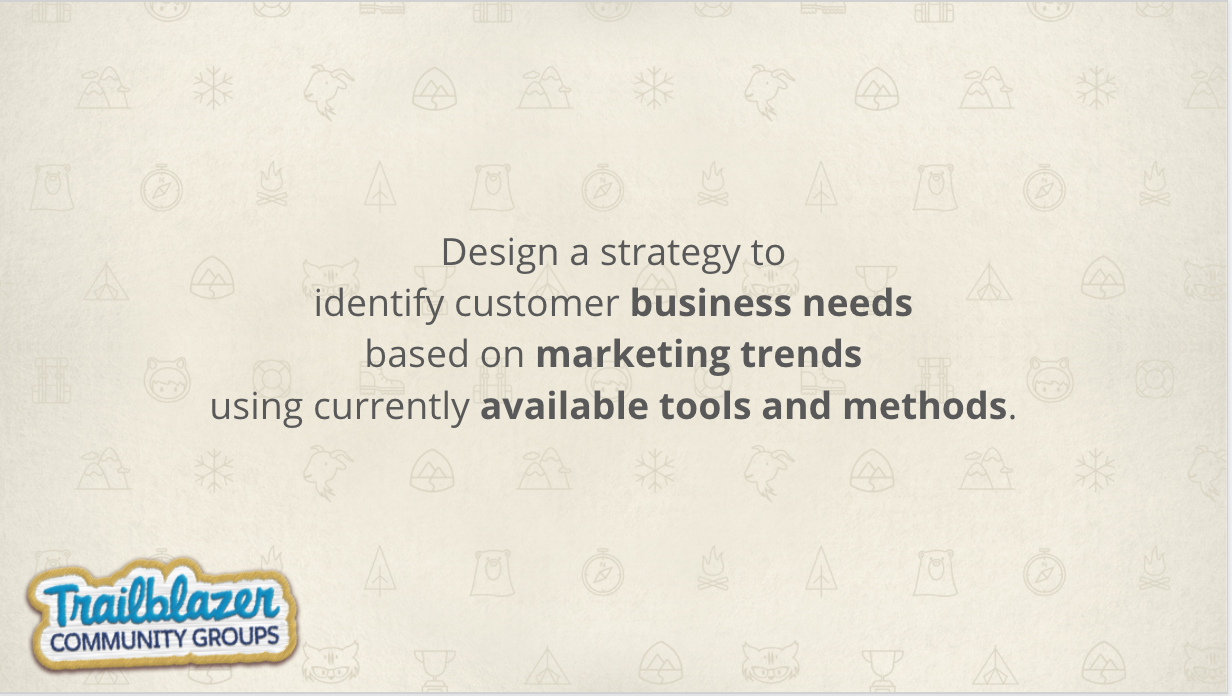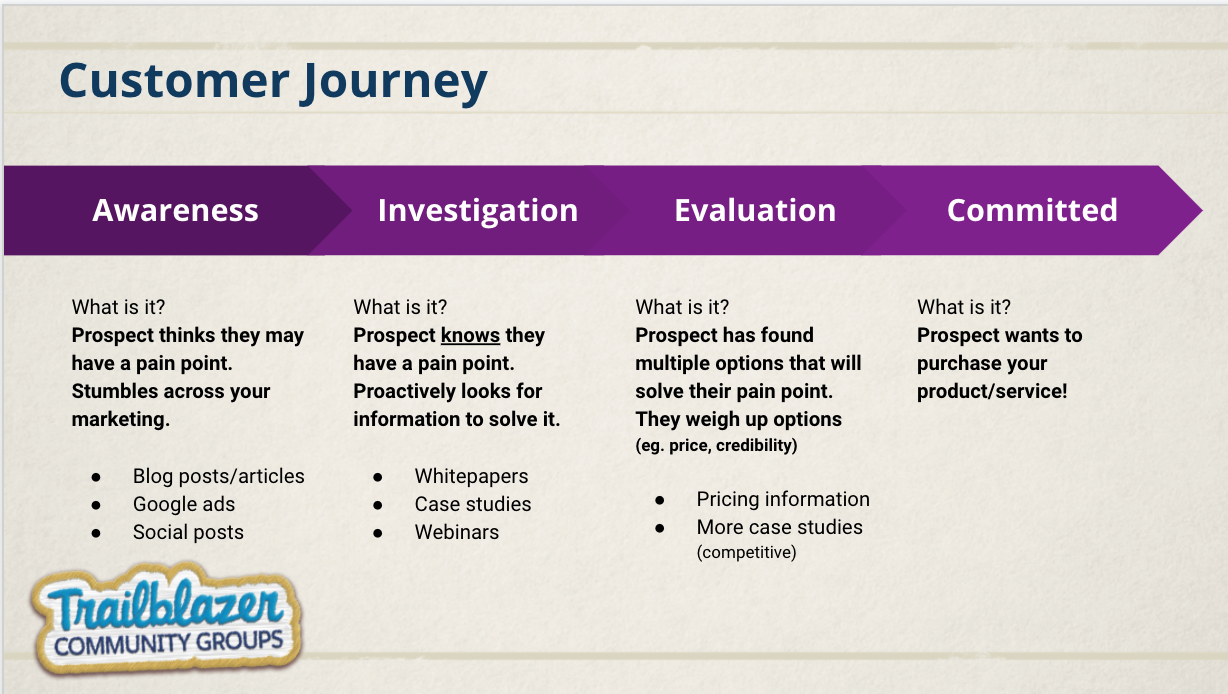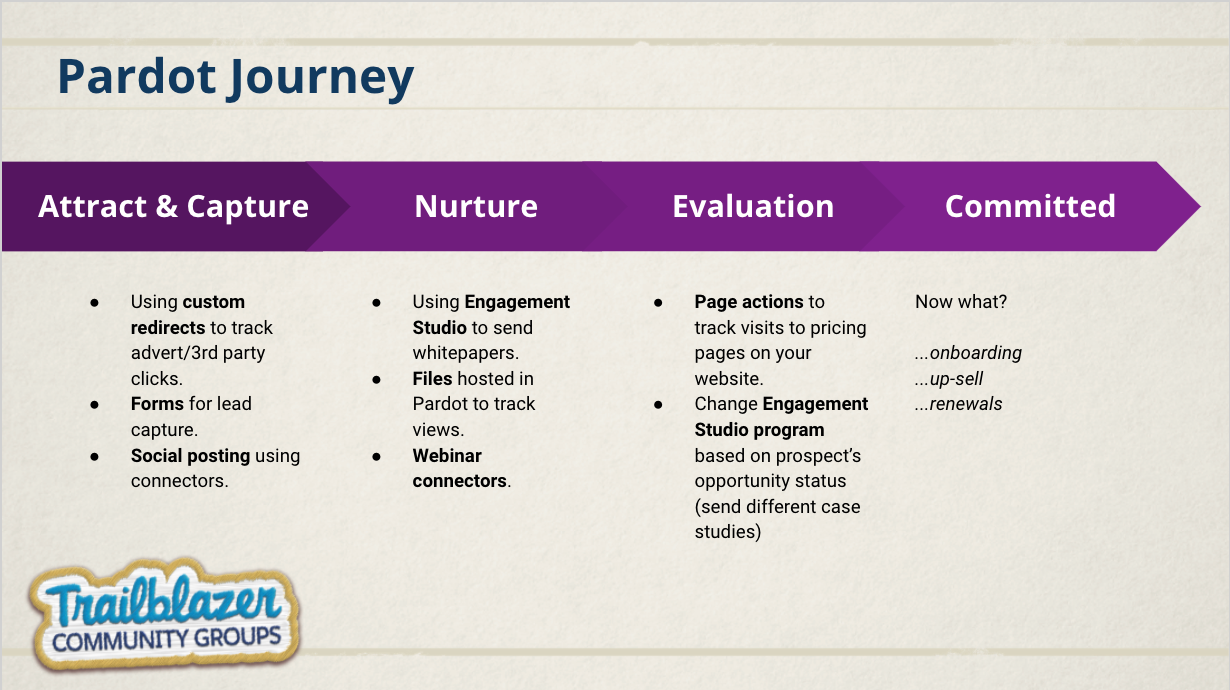The ‘evaluation’ section of the Pardot Consultant exam is the first section of the outline. With its vague requirements and broad scope, it’s tempting to skim across this section.
In my opinion, this is the hardest section to revise for but the most key one to master if you want to become a Pardot consultant and be successful in the long term.
The section comprises of two study requirements:
Given a scenario that includes an assessment of a customer’s current Salesforce and Pardot landscape as well as business objectives, analyze and make recommendations on a path forward.
Design a strategy to identify customer business needs based on marketing trends using currently available tools and methods.
I recently presented this section at the Pardot Consultant Bootcamp, hosted by the Trailblazer Community – here is the recording to follow along as you read:
If you’ve studied for other Salesforce certifications, you may be tired of seeing ‘Given a scenario’ and not knowing where to start. The wording is daunting because neither points to specific areas of the Pardot application or name features. If you feel like you are shooting in the dark, I don’t blame you.
If we zoom out and take a look at the syllabus as a whole, ‘evaluation’ has the 2nd highest weighting (17%) which equates to 10 or 11 questions on the real exam!
Tests your consultant know-how
I recently presented the ‘evaluation’ section at a Trailblazer Community bootcamp. As I was writing the material, I realised how easy it is for knowledge gaps around this topic to form. It’s the hardest section to learn by pure study without practical experience.
The point of the Pardot Consultant certification is to prepare you for a Pardot consultant role (if that’s the next career step you want to take). The exam intends to go beyond naming features and functionality, to really test your consultant know-how.
What I mean is that there’s nothing to learn off by heart and ‘parrot’ back when you take the exam – not like describing what a completion action does, or how to enable the Pardot Lightning App.
According to the Trailhead exam guide, the ideal candidates:
“generally have 12 months or more of hands-on experience implementing and administering the Pardot Lightning App and Salesforce platform…possesses facilitation and consultative skills to gather the business requirements, design solution alternatives, and implement them to meet business needs.”
The exam guide stresses you should have hands-on experience before attempting this certification because of sections like ‘evaluation’ that are hard to master otherwise.
How to Become a Pardot Consultant
What does it mean to be a ‘consultant’? The first image that comes to mind may is someone that is specialised in Pardot, working for a Salesforce consulting partner.
However, being an advisor in your organisation also counts as being a ‘consultant’, just that you are working with internal teams instead of clients. Your colleagues are your clients that seek your knowledge and hold you accountable to deliver solutions.
Here are some questions to ask yourself that you may relate to:
- Are you problem solving?
- Are you regarded as the knowledgeable person at the table?
- Do you pause to think ‘if this, then what happens’?
- Do you listen to the whole story before jumping to a solution?
- Do you not simply take what people tell you and implementing blindly?
If yes, then you sound like a consultant!
Evaluation Part 1: ‘Given a scenario…’
Let’s get back to the exam guide and how to tackle two study requirements in your Pardot Consultant exam preparation. It’s wise to first break down what the exam outline is asking here. Instead of sweeping the more vague study requirements ‘under the rug’, I want us to stare them down, and pick them apart.
If you’ve studied for other Salesforce certifications, you may be tired of seeing ‘Given a scenario’ and not knowing where to start. This is the wording on the official exam outline:


You will see that this first requirement is actually broken down into three parts:
- Assess their current Salesforce and Pardot landscape
- Identify their business objectives
- Combine that information to make recommendations


Assess Their Current Salesforce and Pardot Landscape
Every Pardot account and connected Salesforce org is going to be different. There are so many variations in how their orgs are configured to fit business needs, the features they’ve enabled, and any add-on products they’ve purchased (eg. B2B Marketing Analytics, Salesforce Engage).
The main points to look into when you approach a new Salesforce/Pardot org or when you kick-off a new project are:
Inbound data, Leads, Accounts & Contacts, Campaigns, Custom Objects, Users, Reports, Connectors & Integrations.
I have put together a list of questions that I would use during the ‘discovery’ phases of projects. There are 30+ questions for you to use – so check them out.
Identify Their Business Objectives
When an organisation invests in marketing automation, there are reasons that most organisations share in common, whereas other objectives will vary greatly from business to business.
Common marketing automation objectives:
- Reduce the length of the sales cycle (eg. from lead → opportunity, from ‘Qualification’ stage → ‘Closed’)
- Improve conversion rate
- Re-prioritizing where marketing budget is spent to achieve higher ROI
- Generate more leads
- Increase the number of MQLs (to hand over better quality leads to sales)
- Increase the number of sales meetings
- Improve lead nurturing (for reactivation campaigns to recycle leads)
Other marketing automation objectives:
- Launch a new product line/brand
- Target organisations in a specific industry/size/geographic region, eg: the manufacturing industry, or enterprise level organisations with 10,000+ employees
- Reduce the budget spent on lead generation
- Use Pardot for other ‘B2C-like’ use cases, eg. e-commerce (I have been part of a project like this)


This screenshot is from an old Pardot Office Hours video. Why have I dug this out of the archives? These customer case studies outline typical business objectives.
- “Reduced the length of their sales cycle by 29%”
- “Increased their conversion rate from inquiry to signed client by 34%”
- “Re-prioritized spending based on Pardot campaign reporting”
- “Saw $1,163,060 in retail revenue from marketing automation campaigns”
- “Increased monthly lead generation 2x and website lead conversions by 30%”
- “10% increase in the number of sales appointments set”
- “Increased MQLs by 300% in one year”
- “Created highly-targeted nurturing tracks for different segments of buyers”


Make recommendations on a path forward
This is the final piece of the equation where we combine the information we gathered to make recommendations:
Current Salesforce and Pardot landscape + business objectives = recommendations
Evaluation Part 2: ‘Design a strategy to…’
Now on to the second study requirement:


Again, we can break this down into three manageable chunks:
- Identify their business needs
- Use available tools and methods to find data trends
- Combine that information to design a strategy


Identifying business needs is very similar to what I covered above, so I will dive straight into the second point.
Use available tools and methods to find data trends
Your job is to paint a picture of an organisation’s context using their data. Only by understanding where they currently are will you be able to put together a strategy that will significantly improve their marketing outcomes. Again, every Pardot account and connected Salesforce org is going tell a different story.
You need to know:
a) which data sources you have at your disposal,
b) what you’re looking out for.
Data sources
Luckily, Pardot/Salesforce customers have many analytics capabilities to use. Don’t forget other sources of data that don’t involve looking at screens – I’ve included these human (and very rich) sources in my list, too.
What should you be looking out for? Some examples that came to mind include velocity, bottlenecks, high/low volumes, prospect mailability – find these and example questions in the deeper dive here.
Design a marketing automation strategy
With that information, you need to design a strategy. This involves outlining a customer journey that will make improvements where the business’s marketing is failing, or where marketing can support where other teams are failing.
This is an example of a ‘slimmed down’ customer journey. I have chosen to include 4 stages – awareness, investigation, evaluation, committed – you will come across different frameworks, which often have many more stages. I won’t go into detail right now – I saved that for the deeper dive post here.


That’s a great start, now a consultant should be able to translate what’s on the diagram into a ‘Pardot Journey’. You have to think about which Pardot functionality enables these marketing activities to happen ft prospects, at the right time. Here is a high-level example of what could be used at each stage within Pardot that puts the customer journey into action:


For more information, visit the guide:
Final thought
The ‘evaluation’ section is the hardest section to revise for, in my opinion, because it requires you to face a given scenario head on and explore marketing automation more broadly. Knowledge of Pardot features will only get you part of the way – the rest is up to you to think like a consultant.


